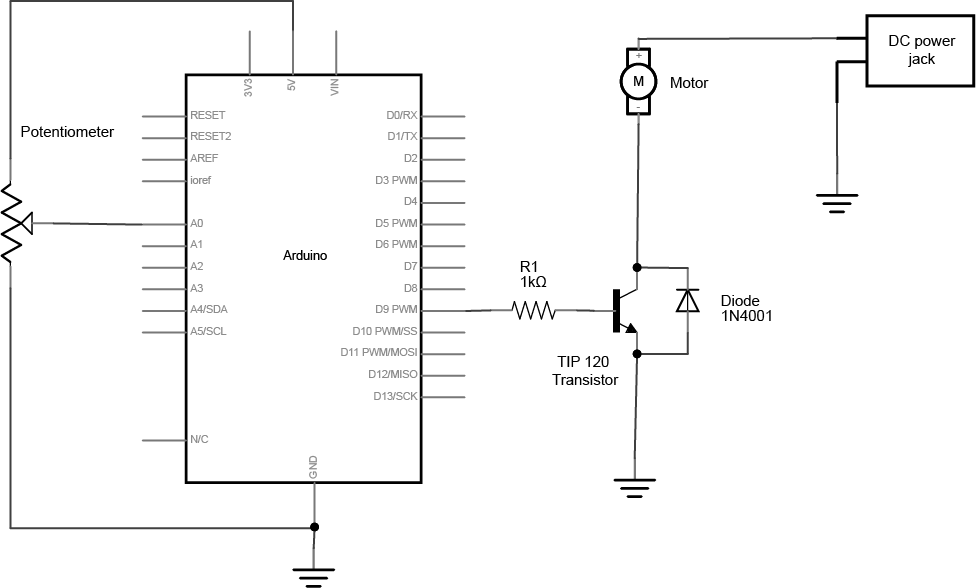Arduino N Channel Mosfet
- N Channel Mosfet Circuit
- Arduino Mosfet Circuit
- Arduino N Channel Mosfet Circuit
- Mosfet As Switch Arduino
- Arduino controlling a h-bridge with PWM at about 4kHz. Two digital outputs and one PWM output are used. The h-bridge is using NAND gates to prevent hi.
- This is the secondary MOSFET that acts as a switch for the Arduino output pin to pull down the Gate of the main power MOSFET. Add a 10k resistor from the Gate of the N-Channel MOSFET to the GND. This resistor ensures that the N-Channel MOSFET is turned OFF while Arduino is powered OFF.
- May 1, 2018 - Explore gabe welch's board 'Arduino' on Pinterest. See more ideas about arduino, arduino projects, electronics projects.
Introduction: How to Control a MOSFET With Arduino PWM
In the case of the N-channel such as the IRF630 when the gate (G) is greater than 5-volts the LED cuts on. The resistor on the gate of the N-channel MOSFET is used to bleed-off the electric charge from the gate and turn off the MOSFET. The resistor can be 5K-10K. In this case, use a P-Channel MOSFET to turn the relay on from the Arduino’s I/O pin. If your load voltage is higher, like 12 or 24V, then you might want to use an N-Channel MOSFET in a “low side” configuration.
In this instructable we'll look at how to control the current through a MOSFET using an Arduino PWM (Pulse Width Modulation) output signal.


In this case we'll manipulate the arduino code to give us a variable PWM signal on digital pin 9 of the arduino, and we'll then filter this signal to give us an adjustable DC level which can be applied to the gate of the MOSFET.
This will allow us to control the transistor from an off state with no current flowing to a state where only a few milliamps of current flow or to a state where we have several amps of current flowing through the transistor.
Here I'll set up the PWM so that we have 8192 steps of pulse width variation which give us very fine control over the MOSFET.
Step 1: Circuit Diagram
The circuit is very straightforward. The PWM signal from pin D9 of the arduino is integrated or filtered by the combination of R1 and C1. The values shown work well an operating frequency of 1.95KHz or 13 bit operation with 8192 steps (2 to the power 13 = 8192).
If you decide to use a different number of steps then you may need to change the R1 and C1 values. For example if you use 256 steps (8 bit operation) the PWM frequency will be 62.45 KHz you will need to use a different C1 value. I found 1000uF worked well for this frequency.
From the practical point of view a PWM setting of 0 means that the DC level on the MOSFET gate will be 0V and the MOSFET will be completely turned off. A PWM setting of 8191 will mean that the DC level on the MOSFET gate will be 5V and the MOSFET will be substantially if not completely turned on.
The resistor R2 is in place just to ensure that the MOSFET turns off when the signal on the gate is removed by pulling the gate to ground.
Provided that the power source is capable of supplying the current dictated by the PWM signal on the MOSFET gate, you can connect it directly to the MOSFET with no series resistor to limit the current. The current will be limited by the MOSFET only and it will dissipate any excess power as heat. Be sure that you provide an an adequate heat sink if using this for higher currents.
Attachments
N Channel Mosfet Circuit
Step 2: Arduino Code
The arduino code is attached. The code is well commented and fairly simple. The block of code on lines 11 to 15 sets up the arduino for fast PWM operation with output on pin D9. To change the PWM level you change the value of compare register OCR1A. To change the number of PWM steps you change the value of ICR1. e.g 255 for 8 bit, 1023 for 10 bit, 8191 for 13 bit operation. Be aware that as you change ICR1 the frequency of operation changes.
The loop just reads the state of two pushbutton switches and increments the OCR1A value up or down. I've preset this value in the setup() to 3240 which is just below the value where the MOSFET starts to turn on. If you use a different transistor or C1 & R1 filter circuit this value will be slightly different for you. Best to start with the preset value at zero the first time you try this just in case!
Step 3: Test Results
With ICR1 set to 8191 these are the results I obtained varying the current between 0 and 2 AMPS:
Arduino Mosfet Circuit
OCR1A (PWM SettingCurrent (ma)Gate Voltage (Vdc)
3240 0 ma 0v
3458 10ma 1.949v
4059 100ma 2.274v
4532 200ma 2.552v
4950 500ma 2.786v
5514 1000ma 3.101v
6177 1500ma 3.472v
6927 2000ma 3.895v
Be the First to Share
Recommendations

Arduino N Channel Mosfet Circuit


Mosfet As Switch Arduino
STEM Contest
Role Playing Game Challenge
CNC Contest
